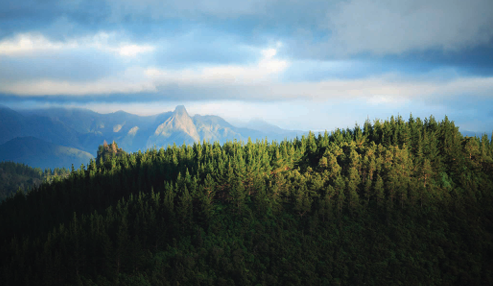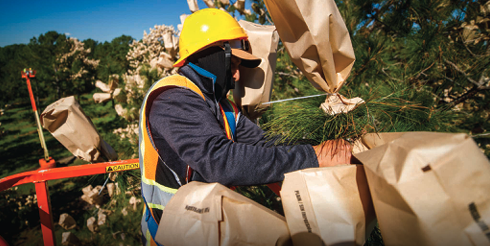Rayonier 2021 Sustainability Report: Climate Change, Risks and Opportunities
Rayonier 2021 Sustainability Report
Climate change is affecting forest ecosystems worldwide, causing shifts in the distribution, abundance, productivity, and health of trees. Rayonier’s commitment to sustainable forest management requires that we understand both the physical and transition risks posed by climate change to our business, the ecosystems we manage, and society in general.
To this end, our internal research team continually evaluates climate change at both a global and regional level, including anticipated changes in weather patterns, in an effort to assess the potential long-term impacts on the health and productivity of our working forests, as well as to develop adaptation strategies.
We believe that traditional forest management practices will need to adapt to the climate conditions that will exist in the future as we strive to maintain productive, healthy, and sustainable forests. By implementing climate smart forestry—strategies and practices designed to manage climate change risks—we expect that Rayonier will be better positioned to mitigate the impacts of climate change in the coming decades. However, this approach will require research, innovation, and flexibility as new risks and opportunities emerge. In developing our climate smart forestry practices, we leverage our in-house exper tise as well as research conducted by external cooperative programs in site classification, forest health, genetics, silviculture, and biometrics.
Physical Risks & Mitigants
The introduction of new diseases/pests or the proliferation of known diseases/pests.
We seek to mitigate this risk primarily through our research and development efforts designed to improve detection, identification, risk assessment, and management inter ventions with respect to disease/pest issues. Specifically, our tree improvement program seeks to identify, select, and reproduce genotypes that are more resistant to diseases and pests. The geographic diversity and dispersion of our forests also serve to mitigate this risk, as disease/pest outbreaks are often localized in nature. Moreover, our active forest management practices are designed to rapidly identify and remedi ate known instances of disease/pest outbreaks on our lands. Lastly, we generally seek to limit our forestry investment in areas that are deemed high risk for major diseases or pests.
The potential increase in the frequency and severity of catastrophic weather events, drought, and forest fires, which increase the risk of casualty loss in our forests.
At a company level, these risks are largely mitigated by the geographic diversity of our timberlands and the physical distance between major tracts of land within our portfolio.
At a localized level, we take deliberate steps to mitigate these risks through targeted forest management prac tices, as different regions may be susceptible to different types of risks. For example, to mitigate fire risks, we pre scribe controlled burns to limit flammable understory and plow fire lines where needed to limit the potential spread of fires. In areas of higher risk in the U.S. South, we also employ our own forest rangers for fire prevention and suppression. To mitigate severe weather and drought risks, we may modify management practices, such as planting density, thinning, and fertilization, in certain areas to increase tree stability, which in turn reduces the likelihood and/or severity of potential casualty damage. For example, as it relates to planting, early and late planting on the shoulder of the planting season may become riskier, as extreme heat events may kill otherwise healthy seedlings. Given bare root seedlings are likely more susceptible to the impacts of climate change, such as drought and heat waves, the use of containerized seedlings to improve survival and growth in harsh conditions is being explored.
Changes in the diversity of plants and trees, due to fluctuations in temperature and rainfall patterns, could impact the long-term growing conditions in our forests.
Through our research and development program, we actively undertake analyses designed to identify, quantify, and mitigate risks associated with long-term changes to the biodiversity within our forests. Our digital land man agement system allows us to monitor species habitats, soils, and other parameters in our forests in order to detect changing patterns. This information, along with our participation in external research initiatives, helps us design plans to effectively address such risks.
Additionally, site quality may change in response to climate change, and preparation practices may need to be modi fied. On certain sites, higher temperatures and droughts may decrease productivity and lead to higher seedling mortality. On other sites, increased rainfall and flooding may make soils wetter (especially on lower landscape elevations), which could alter the suitability of certain species. For example, warming temperatures may make it feasible to plant Douglas-fir at higher elevations than currently recommended, whereas some sites may no longer be suitable for planting because they are too wet.
Rayonier is committed to developing genetic improvement and deployment strategies that create forests better adapted to climate change. As genetic deployment zones begin to change and evolve, breeding and testing efforts should allow us to better evaluate provenance and family performance in a wider range of climate zones to determine the future suitability of seedlots that are cur rently deployed or under development. Improved genetic selection can also enhance drought resistance and the resistance of trees to insects and diseases which increases the resilience of managed forests to climate change.
Transitional Risk Considerations
As the world moves towards a low-carbon economy, the strategies and practices we use to manage the respective risks associated with climate change will necessarily adapt over time. As we look to develop and refine our strategies going forward, we will consider various factors and market developments, including:
- Evolving policy changes around climate change, such as the implementation of laws and regulations to drive the reduction of emissions and/or the use of carbon offsets.
- Emerging technologies such as carbon capture and storage and other potential advancements that will facilitate decarbonization.
- Major shifts in supply and demand for wood products as climate-related risks and opportunities are increasingly considered when evaluating different building materials.
- Water quality policy and standard changes that could impact afforestation, road construction, maintenance practices, and harvesting operations, particularly as rainfall patterns change.
Risk Management and Integration Process
Forest ecosystems play an important role in providing a sustainable economy for the future. As part of the process for establishing our long-term strategies, Rayonier’s Senior Leadership Team and Board consider the potential risks associated with climate change, as well as the strategies we can implement to mitigate these risks. Such strategies include:
- Developing a range of management options to produce forests that resist or tolerate changing climate conditions, as well as focusing on making forests more adaptable to an uncertain future through increased resiliency, flexibility, and optionality.
- Incorporating the impacts of climate change into long-term planning activities such as harvest scheduling, forest modeling, and the determination of sustainable yield.
- Considering the likely risks and impacts of climate change in our assessment of acquisition and disposition opportunities.
- Enhancing our research and development efforts by investing in greater in-house resources, as well as expanding our involvement in industry cooperative efforts to address climate change.
Opportunities
Working forests continually sequester atmospheric carbon dioxide through photosynthesis, thereby providing a natural climate change solution. As such, current climate change dynamics could translate to unique opportunities for timberlands as we increasingly move toward a low-carbon economy. Such opportunities include:
- As companies search for natural climate solutions to offset their carbon emissions, we expect increased participation in regulated and voluntary carbon markets. In turn, this could create incremental value and ancillary revenue opportunities with respect to the carbon sequestration capabilities of working forests.
- Life cycle assessment studies have demonstrated the benefits of carbon storage in wood-based building materials. In a low-carbon economy, the greater use of lumber and engineered wood products such as mass timber could drive increased demand for sawtimber.
- Growing demand for alternative and renewable energy sources could increase the overall demand for land and land use, and thereby provide added optionality for timberland owners. For example, there are emerging opportunities for timberland owners to license properties for solar farms or carbon capture and storage (CCS) solutions.
- Higher levels of CO2 in the atmosphere and changes in rainfall patterns could translate to increased photosynthesis and increased rates of tree growth in certain areas.




